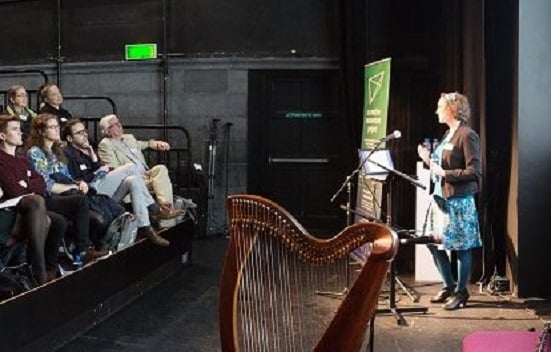
Launch of a creative momentum project at The Dock, Carrick-on-Shannon in Ireland
Photo: Steve Rogers
Distant but not disconnected
Creative entrepreneurs in remote regions risk isolation, but it doesn’t have to be that way. Aisling Murtagh explains how a project in Europe’s Northern Edge is helping to support and connect creative enterprises.
Operating a creative business in a remote location brings its own set of challenges. Entrepreneurs are often located far from each other and their core markets. However, being distant doesn’t have to mean being disconnected.
Aiming to support creative entrepreneurship and business development in peripheral regions, the ‘a creative momentum project’ aims to reduce the challenges that working far from the centre can create.
The project aims to increase exports from the creative sector and has supported enterprises to attend international trade fairs
Co-funded by the EU Interreg Northern Periphery and Arctic Programme, this transnational project is being implemented in the west of Ireland by the Western Development Commission and the Whitaker Institute at National University of Ireland, Galway.
Connecting creatives
Now just over half way into its three-year term, activities are well underway. Through ‘Creative Exchanges’, the project has helped connect creatives locally and develop their skills. For example, last November more than 50 creatives came together in Castlebar at the seminar So Much Data, So Little Time to learn about making use of online data and web analytics.
The project does not just aim to increase the strength of local networks, but also to connect creative enterprises in the project regions to help increase their transnational activity. Through ‘Creative Hotspots’ creatives are supported to attend industry events in the partner regions. Last year creative entrepreneurs from this region attended the Urkult festival in Sweden and Digital DNA in Northern Ireland.
Project partners from the other participating regions also supported creatives to attend these events, facilitating network development between the partner regions. This year the project will support creatives from here to attend Arctic Design Week in northern Finland and Vaka Folk Arts Festival in Iceland.
More broadly, the project aims to increase exports from the creative sector and has supported enterprises to attend international trade fairs. Olyart, producers of contemporary souvenirs, attended the international creative expo Showcase Ireland and design company Leo Scarff Design exhibited at TENT London in September.
Digital showcase
While the project supports connections in physical meeting places, another aspect of a project is to develop a promotion, information and networking space for creatives in the digital world.
MyCreativeEdge.eu, first developed as part of the EU-funded Creative Edge project, is now being redeveloped under a creative momentum project. The website is a highly visual showcase of the creative sector across the partner regions, and entrepreneurs and businesses in the regions can register and set up a profile page detailing their previous work and expertise, and then add content, such as events and blog posts.
The creative places section provides a space to feature information on creative trails, such as craft or artist trails and creative enterprise centres or artist studios. A knowledge centre is also being incorporated comprised of information on support and other resources available to creatives.
Mentoring programme
The project is also encouraging digital networking by connecting peripheral entrepreneurs as part of the transnational peer-to-peer mentoring programme ‘Creative2Creative’.
Fiona Concannon, an artist based in Galway, has been matched with Rachel Sayers from The Culture Standard in Northern Ireland. A number of pairings were made last year and regional coordinators will monitor progress.
Innovation and talent development
Another goal is to support innovation and creative talent to experience and better understand the innovation process. Creative Steps 2.0 matches emerging creative talent with existing businesses that then jointly define an innovation task, such as around a product, service or process development.
Student teams then work on this task through a structured workshop process guided by experts. Creative Steps 2.0 was successfully piloted in Finland last year and will be replicated in this region later this year.
Policy and legacy
Making a contribution to the sustainable growth of the creative sector is the key objective. Through developing evidence that can influence policy, a creative momentum project hopes to help shape the creative sector’s support ecosystem.
The ‘Intelligence and Influence’ aspect of the project will increase an understanding of the creative sector, its economic and social value, as well as what influences its development through developing a creative sector index and conducting an economic impact assessment. The project will also assess creative sector policy, develop a toolkit to help shape creative business models and plan for the sustained legacy of the project.
Aisling Murtagh is a Postdoctoral Researcher at the Whitaker Institute, National University of Ireland, Galway.
www.mycreativeedge.eu
Tw @eucreative
Join the Discussion
You must be logged in to post a comment.